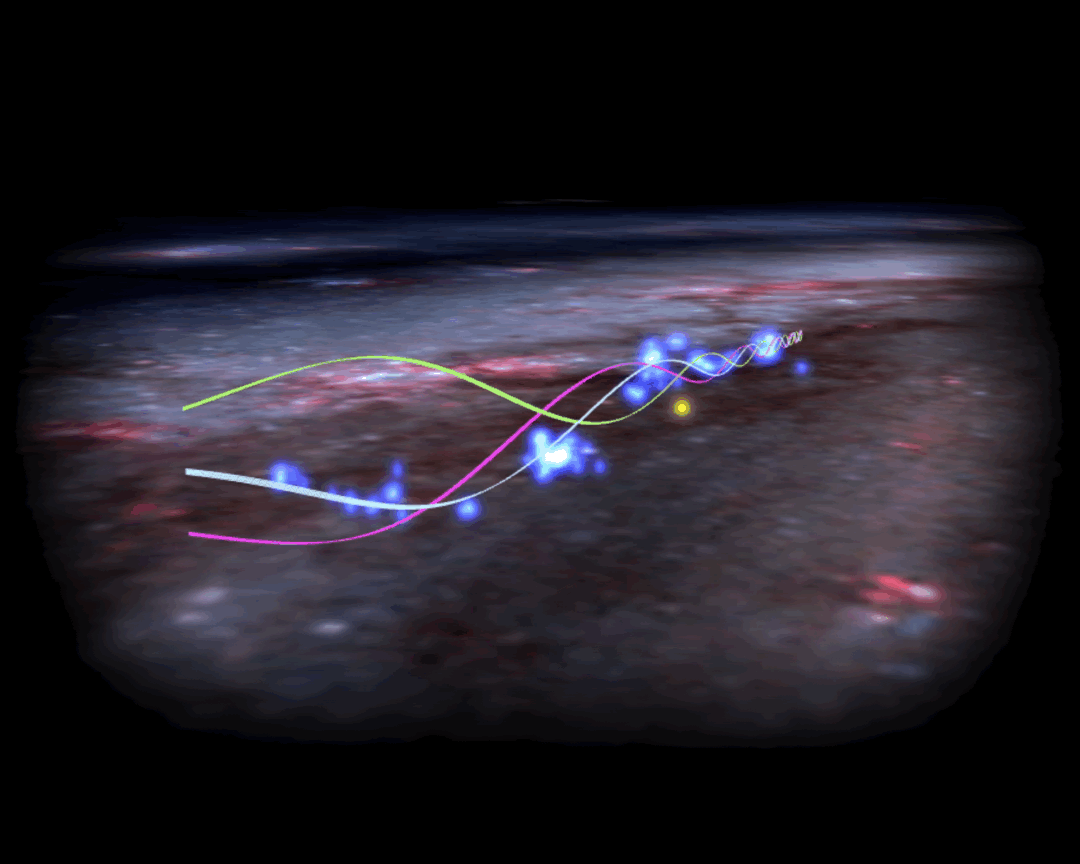Have you ever discovered a “new” place in your neighborhood, perhaps a lovely café or a pretty garden, and then realized that it has been there for a long time and you just never really looked? This is what happened to the astrophysicists who, four years ago, accidentally discovered a gigantic, coherent, wave-shaped gas structure in the vicinity of the Sun. The so-called Radcliffe Wave is an undulating gas chain interspersed with star-forming regions. It extends across half the firmament along the band of stars of the Milky Way from the constellation Cygnus to Orion and 500 light-years above and below the galactic disc. In a new paper published in the journal Nature, the researchers have now shown that this undulating gas chain oscillates around the plane of the Milky Way and drifts away from the center of our galaxy.
Our galactic neighborhood in 3D
We are in the middle of the Milky Way’s star and gas disc and will never get an outside view of our home galaxy. However, we can create a picture of our galactic neighborhood from within and thus determine the shape of the Milky Way. An international team of researchers from Harvard University, LMU and the University of Vienna re-analyzed data from the European space telescope GAIA, which has been mapping the movement of the stars in the Milky Way with extraordinary accuracy for over ten years. With additional measurements of absorbed starlight, they achieved a tomographic reconstruction of the three-dimensional galactic dust distribution. Together with the star movements measured by GAIA, they calculated a dynamic 3D map of all neighboring star groups and gas clouds.
The wave is invisible in the two-dimensional night sky. Only the new 3D technology for mapping interstellar clouds had revealed in previous work the huge wave pattern. The international team for this new publication led by Harvard doctoral student Ralf Konietzka (previously a master's student at the Elite Master Course Theoretical and Mathematical Physics at LMU), including Professor Andreas Burkert, an astrophysicist at LMU and in the ORIGINS Excellence Cluster, as well as researchers from the Universities of Harvard and Vienna, gave new insights. It demonstrated - using 3D movements of young clusters of baby stars near the Sun - that the Radcliffe Wave not only looks like a wave but also moves like one. In other words, it oscillates.
“Using the movement of the baby stars that were born in the Radcliffe Wave, we can trace the movement of their source gas and show that the wave actually oscillates,” says Ralf Konietzka.
Rock-a-bye baby stars
The observed oscillation is consistent with what physicists call a traveling wave. Like waves spreading across the open ocean, the crests and troughs of the Radcliffe Wave shift over time. The baby stars formed in the wave rock up and down, signaling a swaying movement in the galactic disc.
Our sun is (by chance) at the center of the Local Bubble, a growing cavity swept clean by several supernova eruptions and triggering star formation at its margins. Based on the direction of travel of the Radcliffe Wave, one can trace back that the star cluster whose supernovae created the local bubble was probably once formed in a stellar nursery of the Radcliffe Wave.
It is still unclear which processes are responsible for the Radcliffe Wave. Future observations of the motion of star-forming regions in other galaxies could shed light on whether large-scale gas structures like the Radcliffe Wave are common phenomena and may provide clues to their origin. “The exciting question now is how this large disturbance, which is currently passing close to the Sun, came about and what we can learn from it about the structure and evolution of our Milky Way,” concludes Andreas Burkert.
It is still unclear which processes are responsible for the Radcliffe wave. Future observations of the motion of stellar nurseries in other galaxies could yield insights into whether large-scale gaseous structures like the Radcliffe wave are widespread phenomena, along with clues to their origin.
“We can now test the wide variety of theories on how the Radcliffe wave formed, from explosions of massive stars, known as supernovae, to disturbances outside the galaxy, such as a dwarf galaxy colliding with our Milky Way,” says Ralf Konietzka.
R. Konietzka, A. A. Goodman, C. Zucker, A. Burkert, J. Alves, M. Foley, C. Swiggum, M. Koller, N. Miret-Roig: The Radcliffe Wave is Oscillating; Nature, 2024

